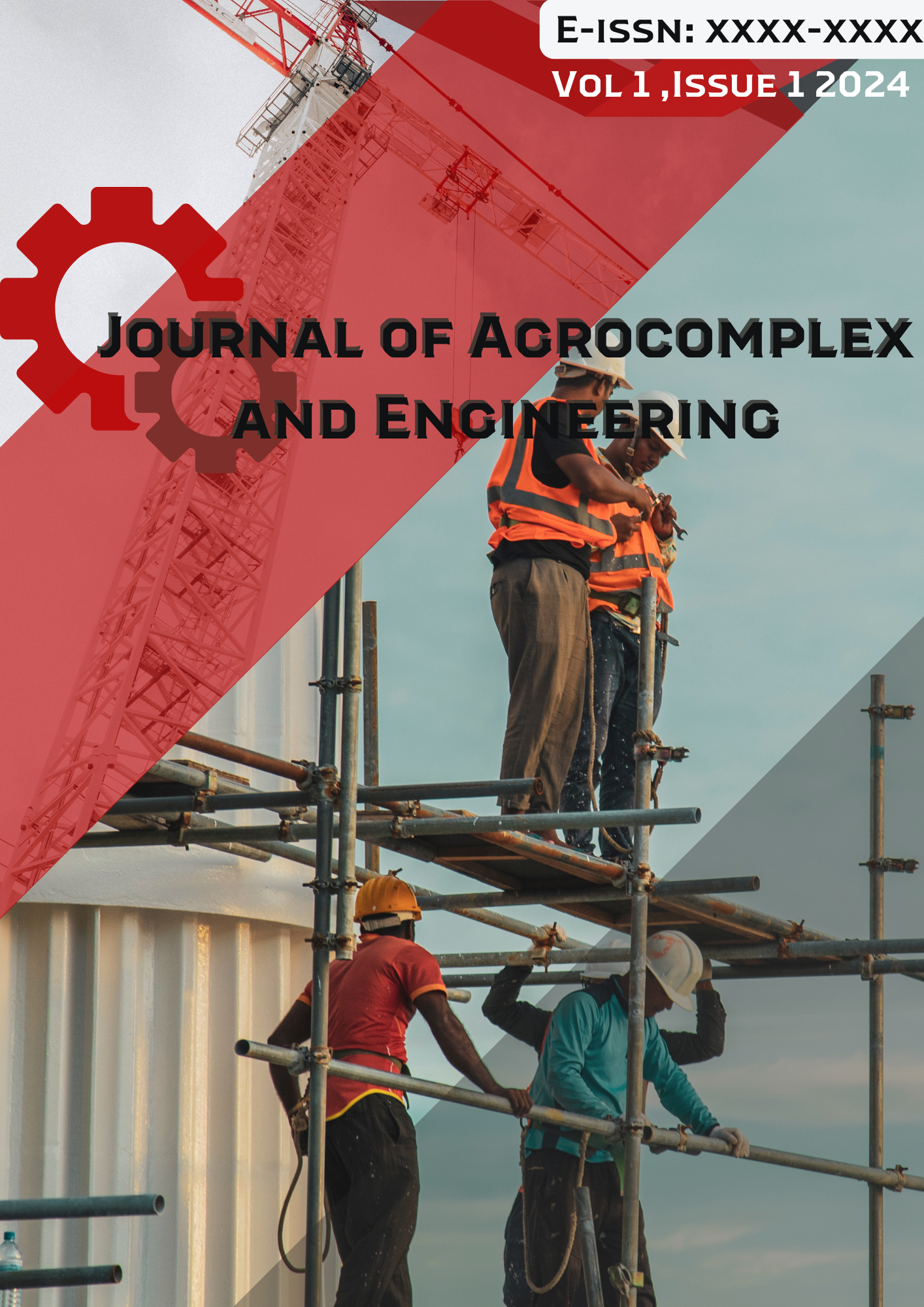Utilization of Palm Oil Waste as Raw Material for Making Environmentally Friendly Biobriquettes
Keywords:
Biobriquettes, Palm Oil Waste, Renewable Energy, Calorific Value, Exhaust EmissionsAbstract
Purpose: This study aims to analyze the potential use of palm oil waste, specifically shells, fibers, and empty fruit bunches (EFB), as raw materials for environmentally friendly biobriquettes. The research focuses on chemical composition, calorific value, combustion time, and exhaust emissions to assess the feasibility of biobriquettes as a renewable energy alternative that can help reduce dependence on fossil fuels.
Subjects and Methods: The research subjects consisted of three types of solid palm oil waste: shells, fiber, and empty fruit bunches. Analysis was conducted on moisture, lignin, cellulose, hemicellulose, and ash content. Biobriquettes were then produced through a carbonization process, mixing with adhesive, and pressing. Calorific value testing was performed using a bomb calorimeter, while exhaust gas emissions measured CO, CO₂, SO₂, and particulate matter. Data were analyzed descriptively and comparatively to determine differences in the performance of each type of biobriquette.
Results: The results showed that palm kernel shells had the highest lignin content (38.2%), the highest calorific value (18.2 MJ/kg), a burning time of 95 minutes, and relatively low exhaust emissions (CO 115 ppm and particulate matter 65 mg/Nm³). Palm fiber produced a calorific value of 15.1 MJ/kg with CO emissions of 130 ppm, while EFB showed the lowest quality with a calorific value of 12.3 MJ/kg and the highest emissions (CO 145 ppm and particulate matter 88 mg/Nm³).
Conclusions: Palm kernel shells have proven to be the most promising raw material for biobriquettes, offering high energy quality and low emissions. Fiber can be an additional alternative, and EFB is more suitable for use through biomass blending or emission control technologies. Utilizing palm oil waste as biobriquettes significantly contributes to energy diversification, industrial waste management, and sustainable energy development in Indonesia.
References
Destek, M. A., Sarkodie, S. A., & Asamoah, E. F. (2021). Does biomass energy drive environmental sustainability? An SDG perspective for top five biomass consuming countries. Biomass and Bioenergy, 149, 106076. https://doi.org/10.1016/j.biombioe.2021.106076
Espinoza-Tellez, T., Montes, J. B., Quevedo-León, R., Valencia-Aguilar, E., Vargas, H. A., Díaz-Guineo, D., ... & Díaz-Carrasco, O. (2020). Agricultural, forestry, textile and food waste used in the manufacture of biomass briquettes: a review. Scientia Agropecuaria, 11(3), 427-437. http://dx.doi.org/10.17268/sci.agropecu.2020.03.15
Foo, K. Y., & Hameed, B. H. (2010). Insight into the applications of palm oil mill effluent: a renewable utilization of the industrial agricultural waste. Renewable and Sustainable Energy Reviews, 14(5), 1445-1452. https://doi.org/10.1016/j.rser.2010.01.015
Hadiyanto, H., Pratiwi, W. Z., Wahyono, Y., Fadlilah, M. A. N., & Dianratri, I. (2023, May). Potential of biomass waste into briquette products in various types of binders as an alternative to renewable energy: A review. In THE 6TH INTERNATIONAL CONFERENCE ON ENERGY, ENVIRONMENT, EPIDEMIOLOGY AND INFORMATION SYSTEM (ICENIS) 2021: Topic of Energy, Environment, Epidemiology, and Information System (Vol. 2683, No. 1, p. 020018). AIP Publishing LLC. https://doi.org/10.1063/5.0125069
Hambali, E., & Rivai, M. (2017, May). The potential of palm oil waste biomass in Indonesia in 2020 and 2030. In IOP Conference Series: Earth and Environmental Science (Vol. 65, No. 1, p. 012050). IOP Publishing. https://doi.org/10.1088/1755-1315/65/1/012050
Kebede, T., Berhe, D. T., & Zergaw, Y. (2022). Combustion characteristics of briquette fuel produced from biomass residues and binding materials. Journal of Energy, 2022(1), 4222205. https://doi.org/10.1155/2022/4222205
Khan, A. U., Jan, Q. M. U., Abas, M., Muhammad, K., Ali, Q. M., & Zimon, D. (2023). Utilization of biowaste for sustainable production of coal briquettes. Energies, 16(20), 7025. https://doi.org/10.3390/en16207025
Mahlia, T. M. I., Ismail, N., Hossain, N., Silitonga, A. S., & Shamsuddin, A. H. (2019). Palm oil and its wastes as bioenergy sources: a comprehensive review. Environmental Science and Pollution Research, 26(15), 14849-14866. https://doi.org/10.1007/s11356-019-04563-x
Müller, A., Weigelt, J., Götz, A., Schmidt, O., Alva, I. L., Matuschke, I., ... & Beringer, T. (2015). The role of biomass in the sustainable development goals: a reality check and governance implications. Institute for Advanced Sustainability Studies (IASS). IASS Working paper, 1-35.
Olujobi, O. J., Okorie, U. E., Olarinde, E. S., & Aina-Pelemo, A. D. (2023). Legal responses to energy security and sustainability in Nigeria's power sector amidst fossil fuel disruptions and low carbon energy transition. Heliyon, 9(7).
Seboka, A. D., Ewunie, G. A., Morken, J., Feng, L., & Adaramola, M. S. (2024). Potentials and prospects of solid biowaste resources for biofuel production in Ethiopia: a systematic review of the evidence. Biomass Conversion and Biorefinery, 14(24), 30929-30960. https://doi.org/10.1007/s13399-023-04994-0
Siagian, U. W. R., Wenten, I. G., & Khoiruddin, K. (2024). Circular economy approaches in the palm oil industry: Enhancing profitability through waste reduction and product diversification. Journal of Engineering and Technological Sciences, 56(1), 25-49. https://doi.org/10.5614/j.eng.technol.sci.2024.56.1.3
Sulaiman, F., Abdullah, N., Gerhauser, H., & Shariff, A. (2011). An outlook of Malaysian energy, oil palm industry and its utilization of wastes as useful resources. Biomass and bioenergy, 35(9), 3775-3786. https://doi.org/10.1016/j.biombioe.2011.06.018
Sumathi, S., Chai, S. P., & Mohamed, A. R. (2008). Utilization of oil palm as a source of renewable energy in Malaysia. Renewable and sustainable energy reviews, 12(9), 2404-2421. https://doi.org/10.1016/j.rser.2007.06.006
Vaish, S., Kaur, G., Sharma, N. K., & Gakkhar, N. (2022). Estimation for potential of agricultural biomass sources as projections of bio-briquettes in Indian context. Sustainability, 14(9), 5077. https://doi.org/10.3390/su14095077
Downloads
Published
Issue
Section
License
Copyright (c) 2025 Journal of Agrocomplex and Engineering

This work is licensed under a Creative Commons Attribution-ShareAlike 4.0 International License.






